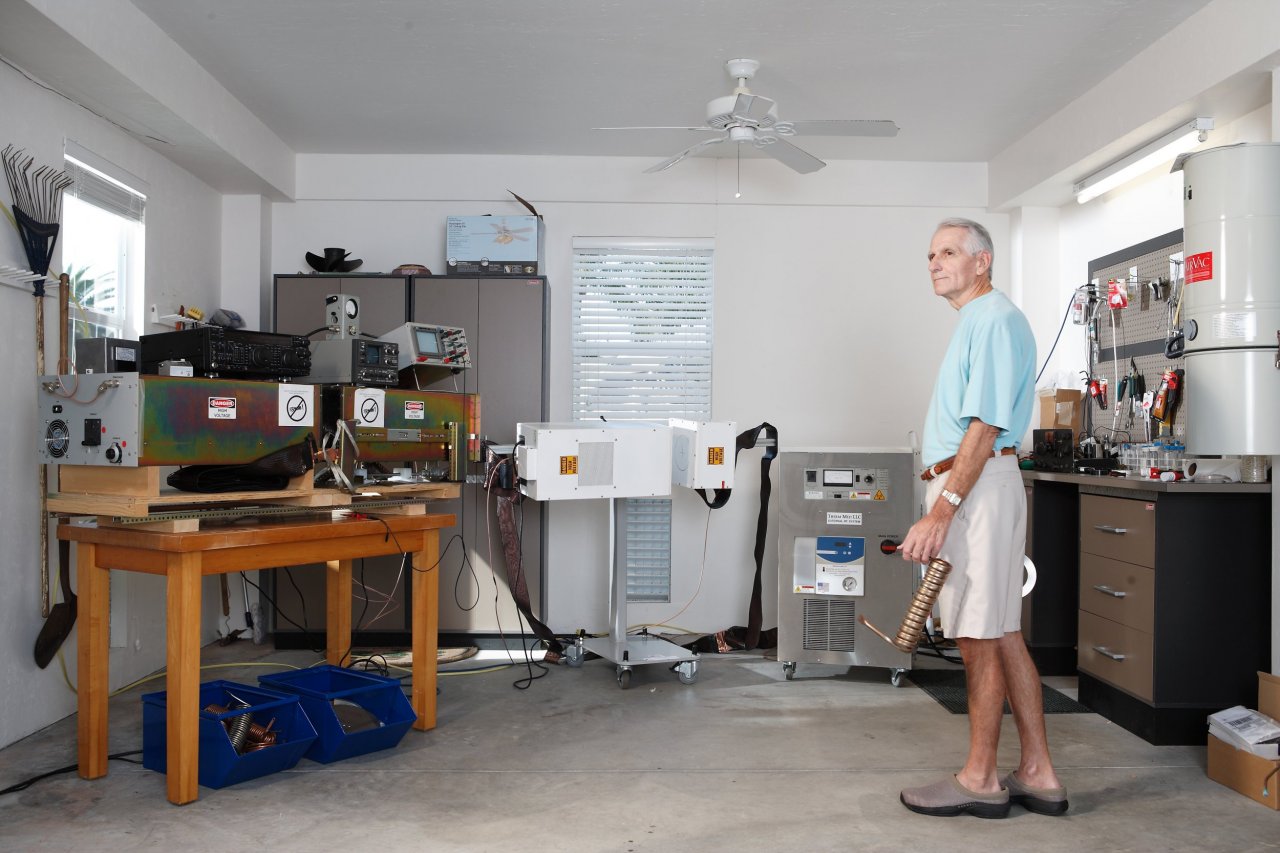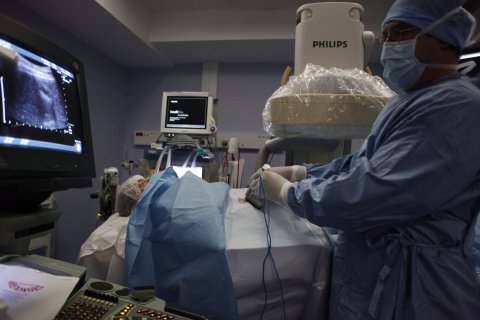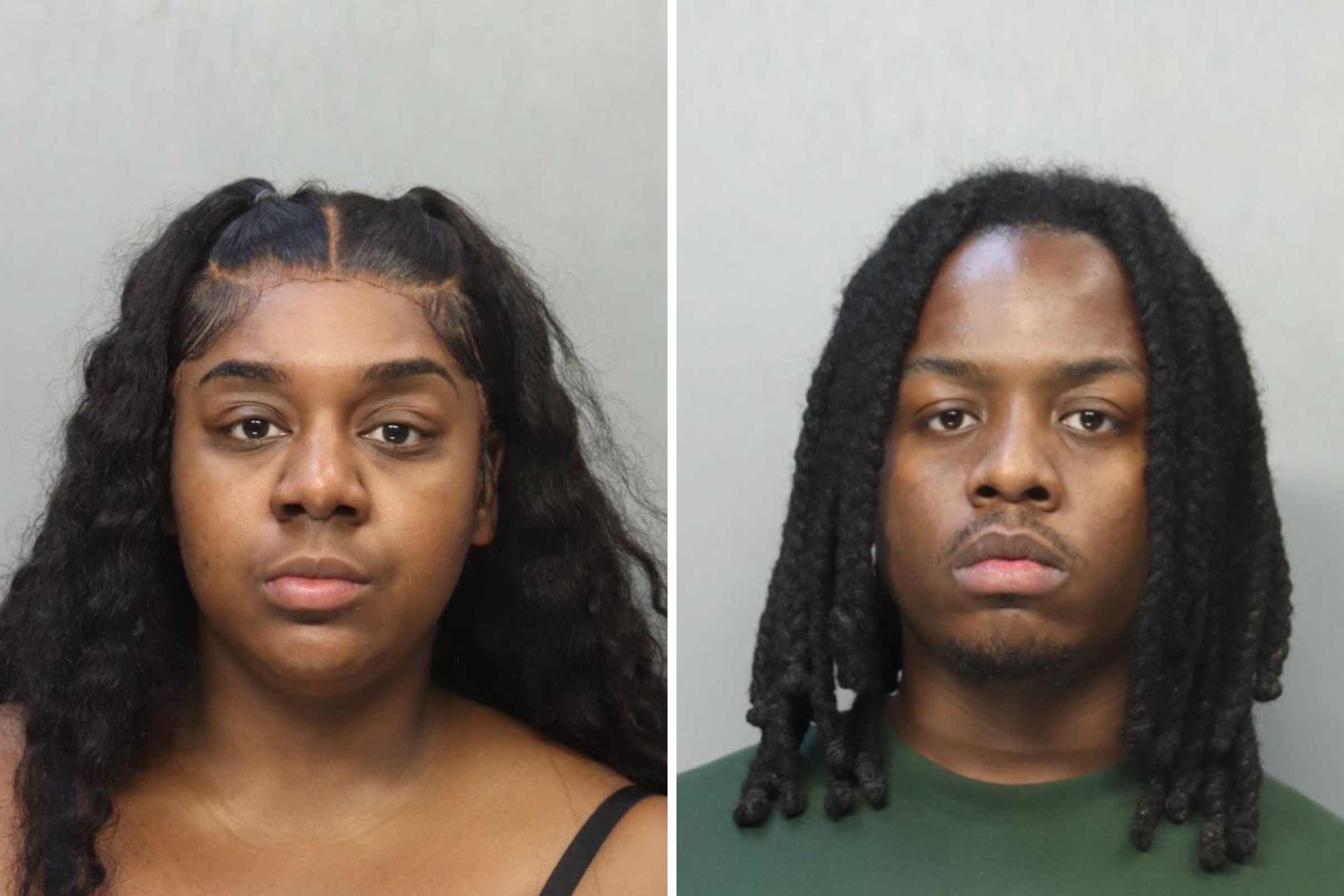
His body ravaged by chemotherapy treatments, retired radio engineer John Kanzius spent months in his basement in 2003 cobbling together a makeshift tumor-killing machine. Kanzius had no medical background. He had been a ham radio operator and the owner of a television and radio station company. But he had leukemia, and he did not want to die.
He was also sharp, dogged and a quick learner. He immersed himself in scientific studies, poring over the latest cancer research. Radio waves heated metal, and he wondered if they could be safely transmitted into humans to destroy tumors. He did not know it then, but the John Kanzius's Noninvasive Radiowave Cancer Device that evolved from this thought experiment would eventually make the pages of respected medical journals and attract the support of leading cancer researchers, as well as a Nobel Prize winner. When I interviewed him in his Erie, Pennsylvania, home in 2007, he vowed to live to see the day that his device would treat humans. He also desperately wanted to cure himself.
Dr. Steven A. Curley, an oncologist then at MD Anderson Cancer Center in Houston who launched Kanzius's research into the national spotlight and devoted his career to the project, visited him in the hospital in 2008. Curley had treated many cancer patients, but over the previous five years he had grown particularly close with Kanzius. "I don't think I've got long to go," Kanzius told Curley. "I just want you to promise me that you won't give up. You will get this to human trials."
Curley promised he would. "I believe in this," he said. "It has unbelievable potential."
In 2009, Kanzius died at 64 from pneumonia while undergoing chemotherapy. Many thought the Kanzius machine would die with him.
But this May, Curley filed protocols with the Italian Ministry of Health to test the radio wave machine on humans diagnosed with pancreatic and liver cancer. Pending approval in the fall, human clinical trials will begin in the spring of next year in Naples, Italy.
Burning Red Meat
The device Curley will use for clinical trials looks much different from the first one Kanzius built. He's now on the sixth-generation version. Looking back at the original machine, "it was very basic," Curley says. "But it got the job done."
It began with some antennas, copper wires and copper sulfate solid that Kanzius hunted down. He combined them—along with some of his wife's pie pans—into a radio wave transmitter device. With it, Kanzius proved that when stabbed with metal prongs and zapped with radio waves, areas of hot dogs and slabs of liver and steak would burn while the rest of the meat remained unaffected.
Invigorated, Kanzius secured a patent and tracked down Curley, who specialized in radiofrequency ablation (which involves inserting needles into tumors and zapping them with electrodes—a method that heats and kills them, but can't reach all tumor sites and sometimes damages surrounding cells). Curley recalls: "His physician called me and said, 'Look, I've got this patient who has read your work. He thinks he's got a better idea for curing cancer, and he won't leave me alone. Would you talk to him?'"

Curley gave Kanzius a call, and after listening to him explain his invention, told him he needed to find a substance that could attach to cancer cells and would burn when blasted with radio waves, so as not to damage nearby cells. Nanoparticles, Kanzius replied. They are so tiny that 100,000 of them lined up are about the width of sewing thread. More than 2,000 nanoparticles could fit inside of a red blood cell. Kanzius didn't know how he could get some nanoparticles, and no one actually knew if they would burn, but it was worth a try.
"It was the start of a beautiful friendship," Curley says. He put Kanzius in touch with a Nobel Prize–winning chemist, Richard Smalley, who specialized in nanoscience and was on his deathbed from cancer. Smalley gave Curley two vials of carbon nanotubes, a kind of nanoparticle that is hollow, with a cylinder structure. In June 2005, with Kanzius' encouragement, Curley put them in the machine, which used a pair of antennas with copper coils at each end to send high-voltage radio waves through the nanoparticles. "They heated at a remarkable rate."
To Curley, this meant the machine had the potential to treat cancer without needles, debilitating chemo or invasive surgeries. Combined with nanoscience, it could possibly one day detect and kill the most microscopic of cancer cells, which current machines cannot even find. "It blew my mind," he says. "I started putting together research proposals."
Researchers from the University of Pittsburgh, the MD Anderson Cancer Center and Rice University tested the technology. Curley's team injected nanoparticles into human cancer cells in petri dishes, as well as into tumors in mice, rats, rabbits and pigs. Using the Kanzius machine, they were able to heat the nanoparticles and, as a result, kill all those cancerous cells. Results were published in the oncology medical journal Cancer, as well as Nano Research. They were publicized around the world and featured on 60 Minutes. Over and over again, after being injected with nanoparticles and heated with radio waves, cancer cells died while surrounding healthy areas remained intact.
"We've treated pigs with far higher doses than I would ever use in a human being," Curley says. "We found that animals we treated were fine; their blood tests were fine. It really did nothing in terms of damage to other cells."
Enough to Fight for
Though he had become thinner with his illness, Kanzius still enjoyed expensive fine dining out on the town. Curley accompanied him on some of those drives about town, as residents waved and shouted, "Mr. Kanzius!" He says the locals treated Kanzius like a rock star.
An unabashed optimist, Kanzius sometimes made overreaching claims about his device, telling audiences and fans: "I think I've found a cure for cancer." This always made Curley cringe. He had to explain to Kanzius that it was dangerous to get people's hopes up too high. "I don't tell patients they are cured until eight, nine, 10 years down road—and after proving they don't have microscopic cancer cells hiding somewhere." If the machine led to a more effective, less toxic treatment for cancer, he told Kanzius, then that was a huge accomplishment. That was enough to fight for.
As publicity grew, Curley began receiving hundreds of calls and emails a week from cancer patients and their families. Curley had to tell people, many of whom were on their deathbeds, that the treatment was not yet ready. Still, they persisted. "I will sign a waiver. I will do whatever it takes," they pleaded. Patients promised that if they could come to Curley's lab as secret test subjects, they wouldn't tell anybody. Curley would again say no with apologies. "I get it," Curley says now. "Cancer scares the hell out of people." Other people tried to figure out how to build their own Kanzius machine. "One guy sent a video of himself standing between two antennas," Curley says.
Kanzius finally stopped telling people he had a cure when cancer patients began showing up at his house asking for impromptu treatments. He couldn't actually help; he didn't have any spare nanoparticles. And even if he could get ahold of the nanoparticles, he didn't have a way to get them into the cancer cells. Kanzius knew this, because he tried to treat himself in the summer of 2008. He called Curley and told him he was using the device to channel radio waves into his own body. "I just wanted to see what happened," Kanzius told him. But, of course, radio waves alone didn't seem to make a difference.
Into the Lab
Since Kanzius first built his machine, there have been tremendous scientific advances in both nanotechnology and cancer research. Researchers have shown that nanoparticles can be used to create supersensitive biosensors able to detect cancer cells and even identify molecules that indicate someone is at increased risk for cancer.
Google's life sciences division, for example, has been working on combining nanoparticles with a wearable device to create the ultimate cancer detector. The theory is that nanoparticles could be ingested in a pill, for example, and then enter the bloodstream, where they would bind to a cancer cell. Since the core of the nanoparticles can be magnetic, the wearable device would detect and lure these cells toward it, where they would be counted using light and possibly even radio waves.
Recently, Abhilash Sasidharan at India's Amrita Centre for Nanoscience and Molecular Medicine was so inspired by the work of Kanzius and Curley that he decided to test a similar technique using nanoparticles called graphene—honeycomb sheets of carbon atoms that make up the thinnest solid ever discovered. Graphene is flexible, transparent, highly electrically conductive and stronger than steel.
Sasidharan's team has used radio waves to destroy advanced-stage cancer cells that are highly resistant to other treatments, and found that graphene could heat at higher levels than other nanoparticles—which makes for a more efficient tumor-killing machine. In addition, in comparison to carbon nanotubes or gold nanoparticles—another material currently being investigated for cancer-curing potential—which may be toxic and hard for the body to break down, graphene, Sasidharan says, "is biodegradable; it can be safely used for human applications."
Curley has 20 researchers with expertise in nanomaterials, radiofrequency, immune function and drug delivery functions working in his lab at the Dan L. Duncan Cancer Center at Baylor College of Medicine in Houston, Texas. But he's also been doing clinical research in Italy since 1982—the regulatory processes for human trials there, he says, are not as arduous as they are in the U.S. He did initial clinical trials for his early radiofrequency ablation research in Italy in 1997, which were followed by successful clinical trials in the U.S. a year later.
The first round of clinical trials for the new Kanzius machine design will involve exposing 15 to 20 pancreatic and liver cancer patients to radio waves in the Kanzius machine, primarily to prove the process will not harm them, and to study the impact on their cancer cells. Tests will also examine how effectively radio wave treatments work when used along with known chemo drugs.
The treatment, of course, would need to be approved by the Food and Drug Administration before it could treat patients in the U.S. Curley is hopeful, but more cautious than Kanzius was, pointing out: "A whole bunch of us have been able to cure cancer in animals. You go to humans, and sometimes there are opposite results," he says. "You never know." But like he told Kanzius before he died, Curley deeply believes in the potential. He made a promise to his friend, and he intends to keep it.
This article is one in a series from Newsweek 's 2015 Cancer issue, exploring challenges and innovations in cancer treatment and research. The complete issue is available online and at newsstands.
Correction: The article previously incorrectly stated that Dr. Steven Curley is affiliated with Baylor University. He is in fact affiliated with Baylor College of Medicine.














